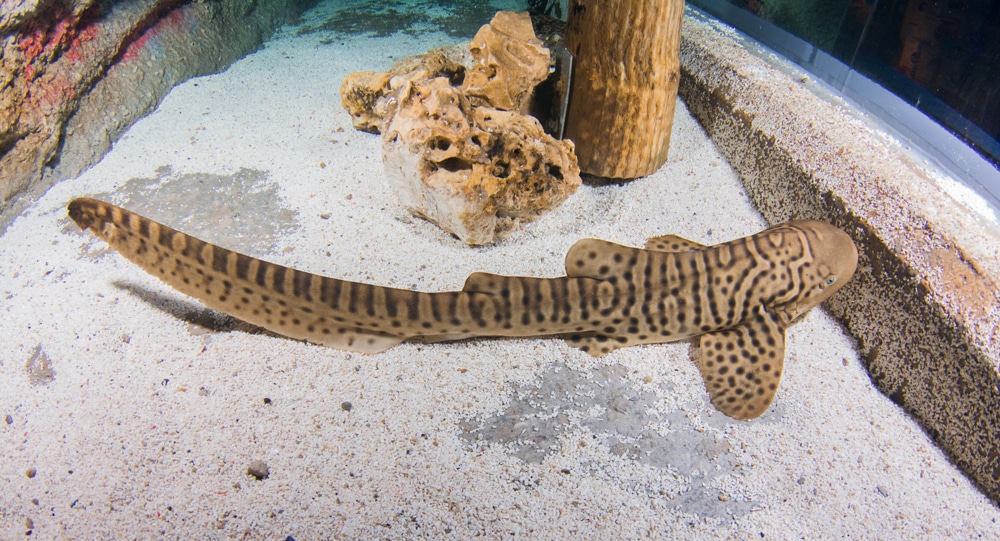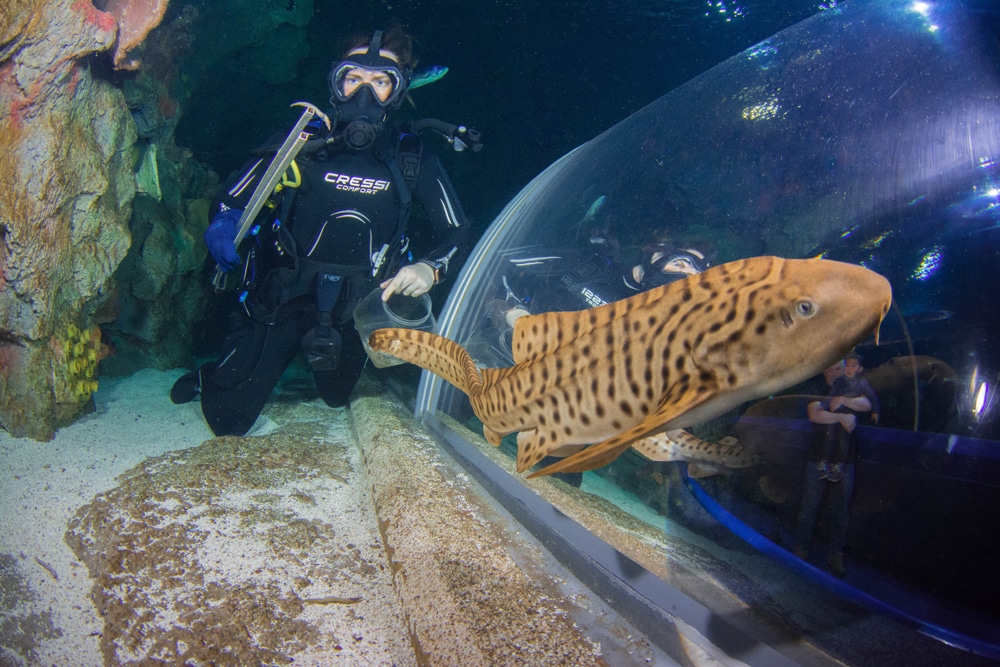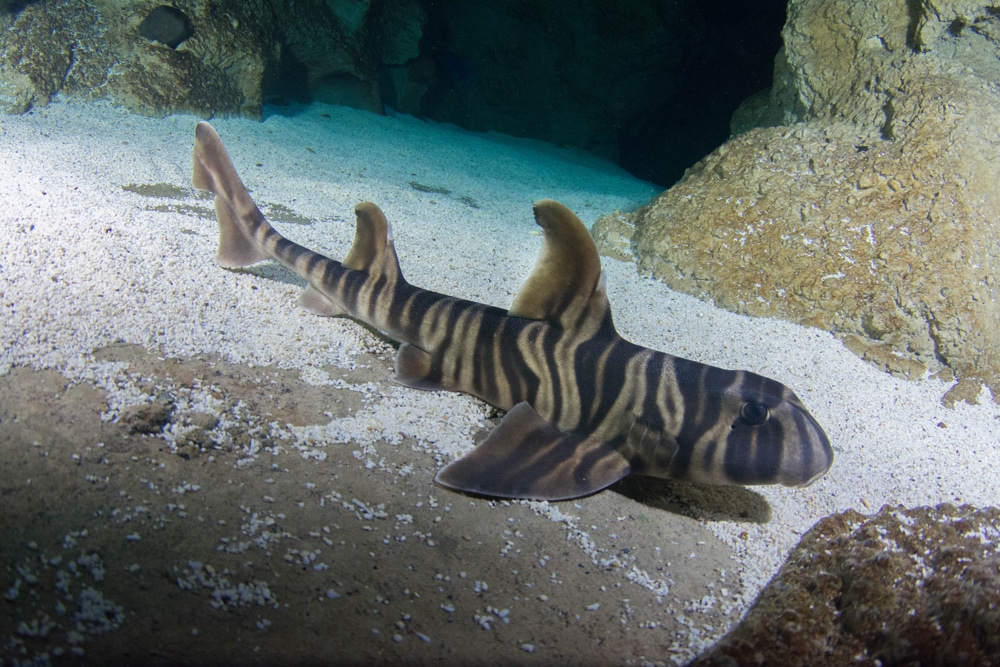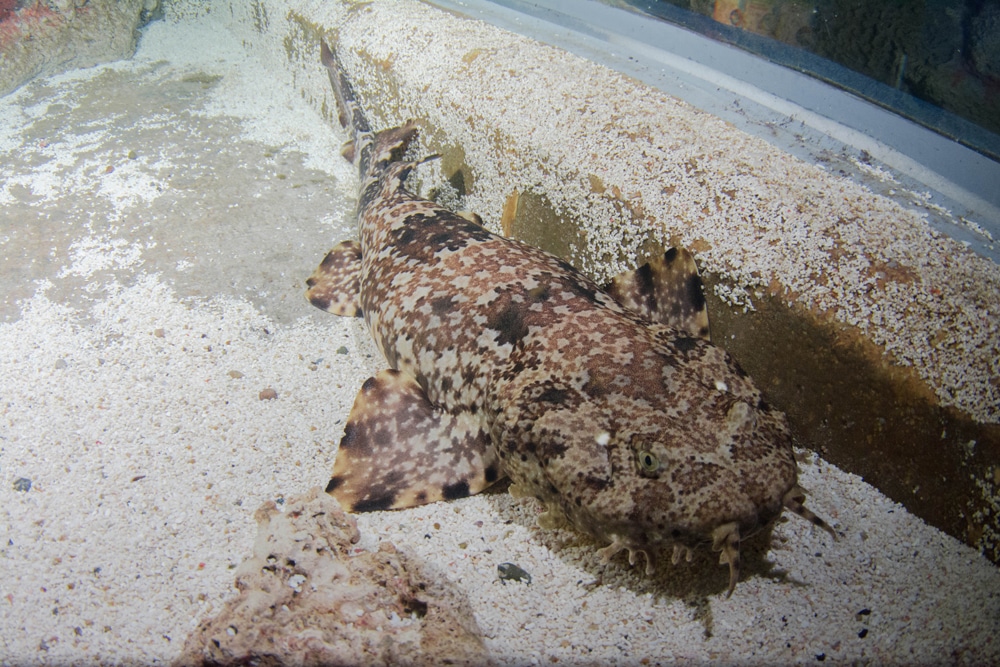Marine Life & Conservation
New Arrivals at Blue Planet Aquarium

 There’s been exciting times recently here at Blue Planet Aquarium, as we have had some new arrivals. When we get new arrivals its always an exciting time to be working in the Aquarium, however recently we’ve had some truly unique and unusual animals to join the rest of our collection of animals. So, this blog is going to be covering the newest members of the Blue Planet family, and why their uniqueness is so beneficial to our other animals.
There’s been exciting times recently here at Blue Planet Aquarium, as we have had some new arrivals. When we get new arrivals its always an exciting time to be working in the Aquarium, however recently we’ve had some truly unique and unusual animals to join the rest of our collection of animals. So, this blog is going to be covering the newest members of the Blue Planet family, and why their uniqueness is so beneficial to our other animals.
The new animals in question are Sharks with one being from a species we already have at the aquarium and two being completely new to the aquarium. Here at Blue Planet Aquarium we’re constantly trying to educate our visitors and show them new ways to appreciate our underwater world and the animals that we have living on this planet we call home.
So, lets dive straight in (no pun intended).
We’re going to start today with an animal that we already have two of and have had at the aquarium for several years, we have one teenage male named Marty (Named after the zebra from the Madagascar film) and Stripes (Named after Racing Stripes) however this new one is still a very young Shark and is a female who we’ve named Deborah the Zebra.
This species is also a hugely popular species here at Blue Planet and I would probably say are a favourite of mine, I am of course talking about our Zebra Shark. Zebra Sharks are identified by their yellowish- brown colouration with a spotty pattern covering their body, people usually ask at this stage why they’re called Zebra Sharks if they have spots. They’re called Zebra Sharks because when they’re young they’ve got Black & White Stripes all the way down their body, similar to that of a zebra, this species also has the second longest tail in the Shark world after the Thresher Shark.
The long tail combined with their striped pattern makes them look similar to that of the White-banded Sea Snake which has also lead some scientists to believe that this species may mimic the snake to deter predators, if this is the case then this would be the first case of protective mimicry in Sharks. Zebra Sharks are also one of the few Sharks that we know exhibit parthenogenesis which means that this species can lay viable eggs without a male needed, however all the pups born through this process will all be females. Zebra Sharks have also been found to share a very close relation to that of the world’s largest fish, the Whale Shark, we know this as their DNA is very similar and the Zebra Shark shares very similar features.
Our Zebra Sharks are all hand fed and eat a wide variety of foods such as Mackerel, Whiting, Saury, Squid and hard-shelled food such as Razor Clam. They’re incredibly friendly and regularly come in to investigate what’s going on, they’ll often rest against us and seem to show interest in having physical contact with members of the dive team, however we try and limit this as they wouldn’t get it in the wild, although sometimes we have to in order to stop them from trying to steal all the food or keep them at a distance that we can work with.
The next new Shark member is our Zebra Bullhead Shark, this is one of the more unusual Shark species that we have. It’s a member of the of the Horn Shark Family which is the same family of sharks as the Port Jackson Shark, this shark is very striking as it has very obvious Black and White Stripes and even more unusually, a small spike on both the Dorsal fin and Second Dorsal Fin which is where the name “Horn Shark” comes from. In this species early stages of life, they have a very similar striped pattern as their adult stage however their black stripes are more of a reddish-brown.
This species in the wild feeds mainly on hard-shelled foods such as crabs and molluscs however they wouldn’t say no to fish, ours is fed on fish, squid, razor clam and Mussel. Here at Blue Planet Aquarium we have just one Zebra Bullhead and ours is a male, this shark along with the next species I’ll be talking about are not yet named as we are having our guests choose names for us. Zebra Bullheads lay eggs rather than live birth, like mammals, and this group of sharks is a very ancient group with a long fossil record, that date these sharks all the way back to the early Jurassic which was around 201 million years ago.
The last two species are some of my personal favourites, which are known as Wobbegong Sharks. The name Wobbegong comes from the aborigine word for “Shaggy Beard”, this has led to them being lovingly known as “Wobbies” in Australia and among Shark enthusiasts. We have two species of Wobbegong here at Blue Planet Aquarium we have one Western Wobbegong and one Spotted Wobbegong, they both look vastly different in their patterns and markings and are one of the most unique and unusual Shark species.
Wobbegongs are Ambush predators that lie motionless on, or in, the seabed, rocky overhangs, crevices and caves. They wait to allow their camouflage to help them blend in with their surroundings, they do this until fish and other small animals come within striking range for the best chance of a successful hunt. To add success to a hunt it has been observed with the Tasselled Wobbegong, that they take part in active luring behaviour which is something seen in animals such as the Frogfish or Alligator Snapping Turtle. This is done with the Shark wedging itself into a cave or crevice with its head at the entrance and the tail curled over the top of its head, they then wave their tail side to side to mimic another fish, this is done to create the illusion that the cave is safe and free from predators and its then that the Shark strikes, grabbing any fish that comes too close.
Here at Blue Planet we feed ours on Squid, Mackerel, Saury, Sprat, Sand Eel and Prawn and we feed them via long pole. We do this as the strike from a Wobbegong is so quick that the human eye cant register it straight away, this also allows us to mimic hunting behaviour by giving the food a “swimming motion” to it which allows the animals to pick their target and hunt for their food rather than just feeding them.
These sharks are really important to us here at the aquarium as not only are they amazing and beautiful but they’re unusual looks and nature make them a reference point to just how diverse and incredible the Shark family is, sure everyone knows what a Hammerhead and Whale Shark is and as amazing as they are its always humbling to be able to show our guests just how unusual the Shark family can be along with the amazing traits and behaviours that comes along with them.
So, there you have it, some wonderful new arrivals here at Blue Planet Aquarium with each one being as amazing as the last. When you’re next at Blue Planet keep an eye out for these amazing new arrivals and make sure to appreciate just how strange and unique they are. Keep an eye out for future new arrivals and I’ll see you in the next blog.
For more information about Blue Planet Aquarium please visit their website by clicking here.
Marine Life & Conservation
Paul Watson Released as Denmark Blocks Japan’s Extradition Bid

Renowned anti-whaling activist Paul Watson has been released from custody in Greenland after spending five months in detention. Denmark’s Justice Ministry rejected Japan’s request for his extradition, citing insufficient guarantees that his time already served in custody would be credited against any potential sentence.
The 74-year-old Canadian-American was arrested on July 21 in Nuuk, Greenland’s capital, when his ship docked to refuel. His arrest was based on a 2012 Japanese warrant related to a 2010 encounter in Antarctic waters. Japan alleged Watson obstructed operations and caused damage to a whaling research ship during efforts to disrupt illegal whaling. Watson has consistently denied these claims, maintaining his commitment to marine conservation.
Denmark, which oversees extradition matters for Greenland, concluded that while the legal conditions for extradition were met, the lack of assurances from Japan regarding time-served credit made extradition untenable.
In a video shared by his foundation, Watson expressed gratitude and relief, saying, “After five months, it’s good to be out… and good to know they’re not sending me to Japan.” He added that the most difficult part of his time in custody was being separated from his two young sons.
Watson is a pioneering figure in marine conservation, known for founding the Captain Paul Watson Foundation in 2022 after decades of activism with the Sea Shepherd Conservation Society. His bold efforts to defend marine life have earned him widespread support, including from celebrities and conservationists. His work has also been featured in the acclaimed reality TV series Whale Wars.
Watson’s lawyer, Jonas Christoffersen, praised the decision, stating, “We are happy and relieved that Paul Watson is now free.” He added that Watson is eager to reunite with his family and continue his vital work.
The arrest occurred while Watson’s vessel, the M/Y John Paul DeJoria, was en route to the North Pacific with a team of 26 volunteers to intercept a Japanese whaling ship. His foundation described the arrest as politically motivated and emphasized that Watson’s actions were focused on ending illegal whaling practices.
Japan resumed commercial whaling in 2019 after leaving the International Whaling Commission, asserting that whale meat is a cultural tradition. Conservationists, however, continue to challenge these practices, highlighting their impact on marine ecosystems.
Despite the challenges, Watson remains steadfast in his mission to protect marine life and bring attention to whaling practices. His dedication to ocean conservation has made him a globally respected advocate for the environment.
Marine Life & Conservation
12 Days of Zero-Waste Fish-mas

This holiday period, the Marine Conservation Society, the UK’s leading ocean membership charity, invites you to make some simple changes to eating fish this Christmas to help our seas.
Dr Kenneth Bodles, Head of Fisheries and Aquaculture at the Marine Conservation Society, said, “During the festive season, our consumption increases, but so does waste. Sustainability isn’t just about where food comes from – it’s also about how you use it. By reducing waste and making the most out of your seafood, you’re not only taking steps to be more ocean-friendly, but can also help to cut costs during what is often one of the most expensive times of the year”.
The Marine Conservation Society has compiled twelve tips on how to consume seafood sustainably with zero-waste this Christmas:
Buy whole fish instead of fillets
Instead of fillets, consider buying whole fish such as salmon, hake, or lemon sole. By adopting a “nose to tail” approach with cooking, whole-baked fish not only feeds a crowd, but also helps to minimise waste and maximise sustainability by using up every part of the animal, including bones, skin, and fat.
Make fish stock
Leftover fish bones or shells can be put to good use by boiling them to make a nourishing fish stock or bisque. This can be frozen and preserved for later use and makes for a flavourful base in a soup.
Make your own fish pâté
Avoid waste by turning leftover fish, such as smoked mackerel or salmon, into a delicious pâté by blending with cream cheese and lemon. Perfect when paired with crackers.
The sustainability of salmon and mackerel varies depending on where and how it is caught or farmed. For more information on green-rated options, check the charity’s Good Fish Guide.
Buy frozen
By purchasing seafood that is frozen or vacuum-packed, this helps to reduce waste by extending the shelf life of your food.
Fish pie
If you’re wondering what to do with leftover cooked fish, why not opt for a classic fish pie with mashed potatoes, leeks, and a cheesy sauce? A sure crowd pleaser on Boxing Day.
Use the head
Don’t forget the fish head! The meat is incredibly tender and flavourful. The charity recommends a cod’s head curry or recreating Fallow’s renowned cod’s head in siracha butter.
By stretching your ingredients further, not only is this a more sustainable way to enjoy seafood, but also cost-effective by repurposing leftovers and cooking creatively.
Boxing Day brunch
Mix leftover kippers or smoked salmon with scrambled eggs for a tasty, zero-waste, Boxing Day brunch.
For best choice, make sure you buy kippers, or herring, from the North Sea and the North Irish Sea.
Zero-waste storage
A top tip from the Marine Conservation Society to avoid waste is freezing fish offcuts to save for future use.
Crisp up the skin
Even leftover fish skin can be turned into a quick savoury snack by crisping it up in an air fryer with a little olive oil and salt.
Anchovies two ways
Leftover anchovies can either be blended with butter to make a delicious anchovy butter or tossed into pasta for a hit of umami flavour.
The charity recommends opting for anchovies caught in the Bay of Biscay for best choice.
Fishcakes
For an easy, zero-waste meal, leftover seafood trimmings can be mixed with mash and fried in breadcrumbs to make fishcakes.
Pickled mussels
Try pickling mussels in 1:1 vinegar and water, with a dash of sugar for a sustainable, zero-waste snack that can be enjoyed well beyond the festive season.
Mussels farmed in the UK are a seafood superhero. Grown using low-impact methods and harvested by hand, they get all the food they need from the sea around them. This makes them one of the most sustainable, ocean-friendly, and cost-effective seafood options.
Players of People’s Postcode Lottery have raised £6.6M towards the Marine Conservation Society’s vital work in making seafood more sustainable.
Laura Chow, Head of Charities at People’s Postcode Lottery, said: “Fish is a festive favourite for many, but making sustainable choices when it comes to how we buy and eat seafood makes all the difference for our ocean. Support from players of People’s Postcode Lottery has helped the Marine Conservation Society further its sustainable seafood work, so that we can all enjoy healthier, better protected seas.”
The Marine Conservation Society encourages you to make sustainable seafood choices a year-round habit, not just for Christmas. To check how sustainable the seafood on your plate is, you can visit the charity’s Good Fish Guide. The Guide helps consumers and businesses identify the most sustainable seafood using a simple traffic light system, based on where and how species are caught or farmed. Green is the best choice, amber means improvements are needed, and red indicates fish to avoid buying.
Zero-waste gift idea
Why not embrace a zero-waste Christmas by gifting a membership to support marine conservation? It’s a meaningful, low-waste gift that helps protect our ocean for generations to come. Memberships start from as little as £5 a month – the price of a sandwich and drink from your local coffee shop.
Find the latest sustainable seafood advice for wild-caught and farmed seafood on the Good Fish Guide, downloadable to your phone from www.mcsuk.org/goodfishguide.
-

 News2 months ago
News2 months agoIconic SS United States to become the World’s Largest Artificial Reef
-

 News3 months ago
News3 months agoBook Review – 52 Assignments: Underwater Photography
-

 Gear News3 months ago
Gear News3 months agoDYNAMICNORD – New German diving brand enters the British market
-

 News3 months ago
News3 months agoExploring Cenote El Pit: A Diver’s Dream
-

 Gear News3 months ago
Gear News3 months agoTry BARE drysuits (and maybe even win one!) this Friday with Sea & Sea at North West Dive Fest
-

 Marine Life & Conservation3 months ago
Marine Life & Conservation3 months agoBook Review: Coral Triangle Cameos
-

 Blogs2 months ago
Blogs2 months agoDive the Egyptian Red Sea this Autumn with Regaldive
-

 News3 months ago
News3 months ago2024 Ocean Art Underwater Photo Competition Announced


















